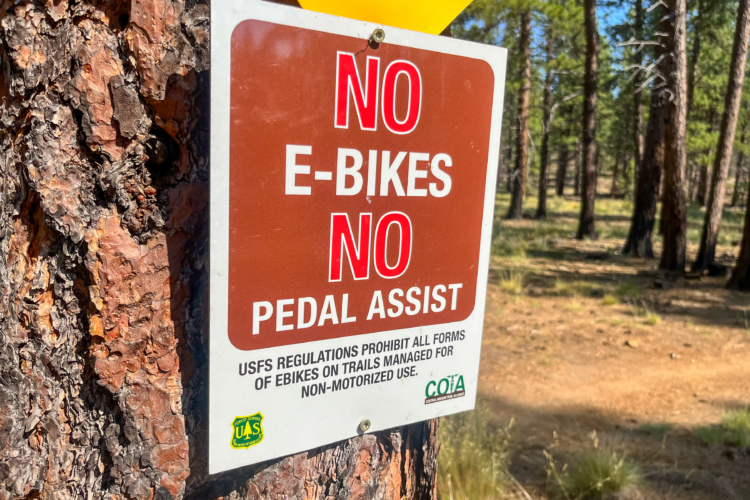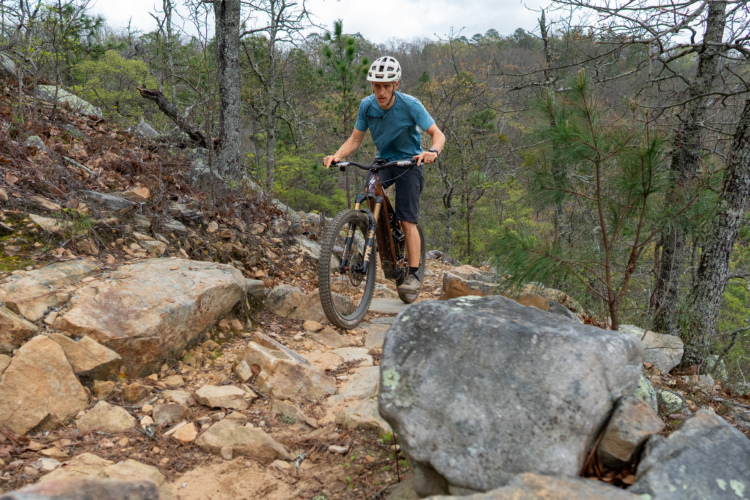
E-bike access isn’t a new conversation in the Lake Tahoe area. Earlier this spring, we reported on the Pines to Mines trail, giving eMTB riders 72 miles of trail in the Tahoe National Forest. Before that, Tahoe has seen some back and forth with allowing e-bikes, eventually resulting in a lawsuit from different user groups.
Now, more trails in the Tahoe area may soon allow e-bikes, according to a proposal from the U.S. Forest Service’s (USFS) Lake Tahoe Basin Management Unit (LTBMU). If passed, e-bikes would gain over 100 miles of trail in the Lake Tahoe basin.
While e-bike trail access may seem to be 2024’s hot topic, the Basin Wide Trails Analysis Project (BWTA) has been in the works for several years. Scoping for the project began in February 2021, and although the estimated decision date of August 1, 2024, has now passed, the USFS says a decision will be made any day now.
Overview of the LTBMU’s trails proposal
Lake Tahoe is massive — 22 miles long and 12 miles wide, with 72 miles of shoreline. It holds 37 trillion gallons of water — enough to cover the entire state of California 14 inches deep. Lake Tahoe’s known depth is 1,645 feet.
Due to its immense size, three national forests extend up to the lake’s basin — the Tahoe, Eldorado, and Toiyabe. Each forest has unique needs that could vary from those of the Tahoe basin, so a separate entity known as the LTBMU was formed in 1973 as a single management unit for the basin.
“The way that you could look at it is if you look at the basin and the way it’s laid out, there’s a ring of mountains that kind of run around the lake,” Lisa Herron, Public Affairs Specialist for the LTBMU, told Singletracks. “Then that’s where the boundary runs for the LTBMU — around the ridge line of Lake Tahoe.”
Like nearly all USFS proposals, the Tahoe Basin Project is multifaceted, with many moving parts. While this project includes adding new trails, the main emphasis is the allowance of e-bikes on existing non-motorized trails. Like we’ve seen in other areas looking to add e-bikes to non-motorized trails, the trails will be reclassified as “motorized trails open to class 1 e-bikes only,” a special USFS redesignation.
Here are some quick points from the proposal:
- Reclassify 87 miles of current non-motorized trail to motorized, e-bikes only
- Build 23 miles of multi-use trail that will allow e-bikes
- Reclassify 1 mile of existing motorized trail to e-bikes only
- Construct 3 new trailheads
The proposal also calls for decommissioning roughly 3 miles of singletrack that have planned reroutes. One mile of the trails being proposed will be open to non-motorized uses, while 5 miles of new trail will be open for seasonal motorcycle use only. Seasonal motorcycle use could get an additional 4 miles of trail currently classified as non-motorized.
The initial proposal was adjusted after the environmental assessment (EA). The number of non-motorized trails reclassified as motorized for e-bikes went from 87 miles to 106. The 23 miles of new trail in the initial proposal was also bumped to 45 miles post-EA adjustment.
“Electric bikes or e-bikes are growing in popularity and offer increased potential for recreational experiences on our National Forest-managed lands in the basin,” LTBMU writes in the proposal. All told, the proposal will open 114 trails (a list of the trails can be found here), both existing and to-be-built, to class 1 e-bikes.
Some popular Tahoe trails that could be allowing eMTBs soon are: Powerline Trail, Angora Ridge, and Saxon’s Connector. The Saxon Creek Trail, also known as Mr. Toad’s Wild Ride, does not yet allow e-bikes, although LTBMU is working with advocacy groups to find alternative access to such trails. The Tahoe Rim Trail will remain non-motorized.
“They’re looking at all the trails, trying to figure out what makes sense and what doesn’t,” Herron told us, referring to the trails opening to e-bikes. “We are just trying to look at the trails and get the best use out of them.”
Support for e-bike access from the Tahoe Area Mountain Bike Association (TAMBA)
TAMBA believes that many of the trails in the Tahoe Basin are compatible with e-bike use. We reached out to Drew Bray, the Executive Director of TAMBA. He pointed us to a couple of documents on their website that go into fairly extensive detail about the addition of e-bikes to the basin.
TAMBA supports the addition of e-bikes to Tahoe Basin’s trails, as they believe e-bikes can be helpful on several fronts. E-bikes could reduce car traffic, as eMTB riders are more likely to pedal to trailheads from home. This proposal will also have new trails connecting neighborhoods, another benefit TAMBA points out.
“When neighboring communities are connected through trails it can offer an easier alternative than driving to trailheads,” TAMBA wrote in a release addressing the proposal. “Connecting neighboring communities through trails reduces the need to drive to trailheads and provides more inclusive access for residents and visitors. This can reduce traffic and emissions, and make Lake Tahoe more accessible to those without a car.”
TAMBA addresses another reality: the growing popularity of e-bikes and the lack of e-bike-friendly trails, especially out west. They mention the BWTA’s attempt to address these issues through the proposal.
“Currently, some eMTB users are riding trails they are not technically allowed on, and this can lead to user conflict. No agency currently has the resources to consistently enforce these policies,” TAMBA’s release reads. “The BWTA seeks to update the regulations to include current users, equipment, and recreation trends on trails.”
E-bikes may not start hitting proposed trails until 2025. USFS Project Milestones tend to be more of a rough guide. The estimated decision date was August 1, 2024, with implementation estimated by September 1, 2024.
With things getting pushed back, Herron told us a decision isn’t likely until mid-to-late August. If the proposal passes, commenters will have a period to object, which adds another 45 days. By then, they could be looking at November.
“If the final decision does come in November, implementation probably won’t happen until after winter’s over,” Herron said. If everything does pass, Herron told us that signage and education will be the most pressing task since building new trail will still be a bit further out.





















7 Comments
Aug 15, 2024
Aug 19, 2024
Aug 14, 2024
Aug 15, 2024
Aug 15, 2024
Aug 15, 2024
Aug 19, 2024